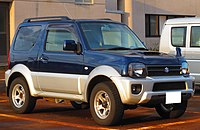Suzuki Jimny
- 3/5-door wagon
- 3-door van
- 2-door convertible
- 2-door pickup truck
- Front-engine, rear-wheel-drive
- Front-engine, four-wheel-drive
- Suzuki Vitara
- Maruti Gypsy
The Suzuki Jimny (Japanese: スズキ・ジムニー, Suzuki Jimunī) is a series of four-wheel drive off-road mini SUVs, manufactured and marketed by Japanese automaker Suzuki since 1970.
Originally belonging to the kei class, Japan's light automobile tax/legal class, the company continues to market a kei-compliant version for the Japanese and global markets as the Jimny, as well as versions that exceed kei-class limitations. Suzuki has marketed 2.85 million Jimnys in 194 countries through September 2018.[1]
History
The history of Suzuki four-wheel drive cars began in the latter half of the 1960s, when Suzuki bought a Steyr-Puch Haflinger to study with the intent of building a kei-class off-road vehicle.[2] A better opportunity presented itself in 1968, when Suzuki was able to buy bankrupt Japanese automaker Hope Motor Company, which had introduced a small off-road vehicle called the HopeStar ON360. The tiny Hope company had been unable to enter series production, and only about 45 were manufactured.[2] The first Suzuki-branded four-wheel drive, the LJ10 (Light Jeep 10), was introduced in 1970. The LJ10 had a 359-cc, air-cooled, two-stroke, in-line two-cylinder engine. The liquid-cooled LJ20 was introduced in 1972 with the cooling changed due to newly enacted emission regulations, and it gained 3 hp. In 1975, Suzuki complemented the LJ20 with the LJ50, which had a larger 539 cc, two-stroke, in-line three-cylinder engine and bigger differentials. This was originally targeted at the Australian market, but more exports soon followed.[3]
The Jimny8/LJ80 was an updated version of the LJ50 with an 800 cc, four-stroke, in-line four-cylinder engine, followed by the Jimny 1000/SJ410 and Jimny 1300/SJ413. An updated version of the SJ413 became known as the Samurai and was the first Suzuki officially marketed in the US. The series from SJ410 to SJ413 was known as the Sierra in Australia, and remained the Jimny in some markets.
The new Jimny was released in 1998, and now bears the same name in all markets. The 1998 release used the G13BB EFI engine, replaced by the M13AA EFI engine in 2001 and the M13AA variable valve timing engine in 2005, in conjunction with a minor interior redesign.
Common design characteristics
Overall construction
All four Jimny generations have separate frame and body ("ladder frame chassis"). The body has no structural carrying role. It serves only as a cabin to protect the occupants from the elements, provide comfort, and protect them in the case of a crash.
Suspension
All four Jimny generations have dependent suspension (solid-beam axles) both at the front and rear axles. This used to be a common suspension design for all-terrain vehicles up to 1990s, but has become a rarity in vehicle design in the 21st century. Dependent suspension is particularly well suited for all-terrain duty, both from the durability and performance perspectives.
The first two Jimny generations used leaf-sprung suspension at all four wheels, with the third and fourth generations using coil-sprung suspension at all four wheels. Some late second-generation models had coil-sprung suspension, as well.
Steering
All four Jimny generations have recirculating ball steering mechanism, which is particularly well suited for all-terrain duty, but relatively imprecise on-road compared to modern rack-and-pinion steering construction.
Transmission
All four Jimny generations have manually user-selectable part-time four-wheel drive (4WD) transmission, where the default (on-road) transmission mode is two-wheel drive (rear-wheel drive). Rear-wheel drive can never be disengaged. The user, however, can (dis)engage the front-wheel drive (FWD) manually at any time under certain operating conditions. When FWD is also engaged, this provides 4WD.
Jimnys have no centre (interaxle) differential. This has a positive effect that at least two wheels, where each wheel is on a different axle, have to lose traction for the vehicle to lose traction when in 4WD transmission mode. However, the negative effect is that 4WD transmission mode must not be used on any surface not rather slippery, especially if having to steer. In other words, 4WD transmission mode should be used only on rather slippery surfaces, like snow, ice, mud, loose gravel, wet grass, and sand. Wet asphalt, wet concrete, and hard-packed gravel are not considered slippery enough.
All four Jimny generations have manually user-selectable dual-ratio (dual-range) gearing mechanism. The two ratios or ranges are called "high range" (for regular on-road driving and light to moderate all-terrain driving) and "low range" (for moderate to hard all-terrain driving and for all-terrain towing). The overall transmission gearing ratio is exactly halved when the vehicle is in low range transmission mode. This has the effect of the vehicle moving about half as fast, but with double torque at the wheels in any transmission gear. For example, the fourth gear in low range behaves similar to the second gear in high range, and third gear in low range behaves similarly as "1.5th gear" in high range. The transmission gearing range is selectable only when the vehicle is in 4WD transmission mode. Therefore, low range cannot be used for on-road towing.
The (dis)engagement of 4WD transmission mode and the switch from one gearing range to another is performed by a dedicated transfer case mechanical unit, which is separate from the regular gear box unit. All four Jimny generations have a transfer case with an attached selection lever protruding in the cabin between the main gear box lever and the handbrake lever. The lever allows the user to select 2WD-H, 4WD-H or 4WD-L transmission modes at will. The only exceptions are later production years of third-generation Jimnys (more info in a dedicated chapter), which do not have a selection lever, but instead have servo-actuated mechanism to perform the same actions when invoked by the push of certain buttons in the cabin.
Factory rear axle differential locker
LJ80, SJ410, and early SJ413 vehicles sold in Germany were fitted from the factory with a manually operated, mechanical rear axle differential locker. A cable connected the locker to a small, dedicated lever in the cabin near the hand brake lever. By operating the lever, the driver could manually fully (un)lock the rear axle differential.
The reason for inclusion of the differential locker was legislative in nature. LJ80s, SJ410s, and early SJ413s have a parking brake that brakes the gears in the transfer case instead of braking the individual rear wheels directly and simultaneously (as with most passenger vehicles). That design has several advantages, as well as an important disadvantage - because of the open rear differential, the hand brake has no effect when the transfer case is in two-wheel drive (rear-wheel drive) mode and when one of the rear wheels is raised in the air. Therefore, relying on the parking brake itself would be dangerous in some unusual situations (when parking on a severely undulated ground). German law required that this risk must not exist. Instead of redesigning the parking brake system for that market, Suzuki appeased the legal requirement by the inclusion of a rear differential locker. The idea was that German drivers, when parking, should lock both the hand brake lever and this additional differential lock lever.
Despite being formally intended as a parking brake assistance only, this rear axle differential locker is a fully fledged device. Therefore, it is perfectly usable and durable in all-terrain driving situations over undulated or very slippery ground.
Later SJ413s (and all Samurais) have a standard parking brake that works on both rear wheels directly. This design appeased the German legal requirement, so no differential locker has been factory fitted to SJ413s nor to any Samurai since.
A retrofit of a genuine rear differential locker to LJ80s, SJ410s and SJ413s which lack it, is possible by using the parts from a dismantled LJ80, SJ410, or early SJ413 which had that locker. Lockers from LJ80 are usable on another LJ80 only, while lockers should be interchangeable between SJ410 and SJ413 and vice versa. A retrofit from SJ41x onto a Samurai is not easily possible, because Samurai has wider track and axle than SJ41x.
HopeStar ON360
The vehicle was originally developed by the Hope Motor Company of Japan in 1967 and available as the HopeStar ON360 from April 1968. It used a Mitsubishi 359 cc (21.9 cu in) air-cooled, two-stroke ME24 engine, which produced 21 PS (15.4 kW; 20.7 bhp) at 5,500 rpm, and 32 N⋅m (23.6 ft⋅lb) of torque at 3,500 rpm.[4] Brakes were Daihatsu units, the rear axle was sourced from the Mitsubishi Colt 1000, and the wheels were sourced from the Mitsubishi Jeep. It was a very basic two-seater vehicle with no doors, but a sturdy 4WD system allowed it to go off-road. Top speed was 70 km/h (43 mph), 30 km/h (18.6 mph) in four-wheel drive mode. The tiny Hope company sold very few ON360s, only 15 in the domestic market and another 30 exported to Southeast Asia,[2] although 100 ME24 engines were purchased.[5][6] Hope proceeded to sell the design to Suzuki in 1968, after Mitsubishi declined to take over production.
First generation (1970)
| First generation | |
|---|---|
 Suzuki Jimny LJ10 | |
| Overview | |
| Model code | LJ10/SJ20 |
| Also called | Suzuki LJ50/LJ55/LJ80 Suzuki Eljot (Germany) Suzuki Stockman (Australia)[7] |
| Production | 1970–1981 |
| Assembly | |
| Body and chassis | |
| Body style | 2-door wagon 2-door convertible 2-door cab chassis[7] |
| Powertrain | |
| Engine | |
| Transmission | 4-speed manual |
| Dimensions | |
| Wheelbase |
|
| Length |
|
| Width | 1,295 mm (51.0 in) |
| Height | 1,660 mm (65.4 in) |
| Chronology | |
| Predecessor | HopeStar ON360 |
The compact off-road capable Suzuki Jimny was Suzuki's first global success, lending it name recognition and a foothold in markets worldwide. The Jimny slotted into a hitherto unfilled gap in the market.
LJ10
Suzuki's first move on acquiring the rights to the ON360 was rebodying it and replacing the Mitsubishi engine with an air-cooled 359 cc (21.9 cu in) Suzuki "FB" two-cylinder, two-stroke, which produced 25 PS (18 kW; 25 bhp). Since the new unit remained smaller than 360 cc, and Suzuki placed the spare tire inside the truck (making it a three-seater) to keep it under 3 m in overall length, it was classified as a kei car, conferring certain tax privileges and other benefits. When it was introduced in April 1970, it was the first four-wheel drive kei car to enter series production. The LJ10 Jimnys had 16-inch wheels, weighed 590 kg (1,301 lb), and had a top speed of 75 km/h (47 mph). The engine was soon uprated to 27 PS (20 kW; 27 bhp), but the claimed top speed remained unchanged.[9]
The original Jimny was an unexpected hit, with nearly 5,000 units selling in its home market in the first year, immediately outselling the market leader at the time, the Mitsubishi Jeep. Over 6,000 were sold in 1971.[2] Production was initially subcontracted and was carried out mainly by hand, but Suzuki soon realized that the Jimny needed to have a dedicated assembly line to allow production to be ramped up.[2]
LJ20
The LJ was updated in May 1972 and renamed the LJ20. The grille bars were changed from horizontal to vertical for the LJ20. The engine was replaced with an updated, water-cooled unit (the L50), and its 28 PS (21 kW; 28 bhp) enabled the LJ to reach 80 km/h (50 mph).[10] With production brought in house, Suzuki could now build 2,000 cars per month.[2]
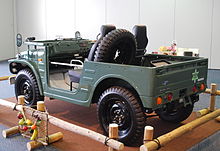
A special version with the spare tire mounted behind the passenger seat allowed for two small rear seats, facing each other. The introduction of left-hand drive signaled Suzuki's worldwide ambitions for the truck. The Hard Top (Van) was also introduced when the LJ20 arrived, equipped with smaller, 15 in wheels.[9] Suzuki did not export them to America; a US company called International Equipment Co. imported them. Export Jimnys had the spare tire mounted on the outside, as kei regulations on length did not apply.
Towards the end of LJ20 production, a cleaner 26 PS (19 kW; 26 bhp) engine was introduced, a result of having to meet ever more stringent emissions regulations. Top speed was reported as 93 km/h (58 mph), payload was 250 kg or 550 lb (200 kg or 440 lb for the Van version).[11]
SJ10

The LJ50 engine was first introduced in September 1975 for export only, with 33 PS (24 kW; 33 bhp). For the home market, it first appeared in June 1976 as the Jimny 55 and reflected the changing kei-car rules and stricter emissions standards. The 539 cc (32.9 cu in) three-cylinder engine remained a two-stroke; while power was reduced to 26 PS (19 kW; 26 bhp), more low-end torque was on offer. The 635 kg (1,400 lb) vehicle could now hit 60 mph (97 km/h), and the spare tire was relocated outside the rear door, allowing for a fourth seat. The SJ10 Jimny originally used the "LJ50" name in most export markets; this was changed to LJ55 with the introduction of the LJ80 to align the names.


In Australia, the LJ50S and LJ50V (van) were available as a soft-top with soft doors and rear-mounted spare wheel or hardtop with full metal doors and external spare wheel through distributor M.W.-Suzuki (Melbourne) with 33 hp (25 kW) and 57.4 N⋅m (5.85 kg⋅m; 42.3 lb⋅ft) of torque. In May 1976, the low-production LJ51P long-wheelbase pickup became available for some export markets. The home-market Jimny 550 received a facelift in 1977, introducing rear wheel-arch metal flares and a bigger bonnet or hood with cooling slots above the radiator, while the export LJ50s were instead replaced by the LJ80 (same external modifications, but with the new four-stroke, four-cylinder, 797-cc engine fitted).
SJ20
The final iteration of the original Jimny design was the 1977 Jimny 8, called LJ80 in certain export markets. It was originally intended to be marketed as the Eljot ("Elliott") in Germany, but copyright issues with Disney's Pete's Dragon movie made this impossible. While the SJ10 remained in production for the domestic kei category, the new 770 kg (1,698 lb) SJ20 boasted a 797 cc (49 cu in) four-stroke SOHC four-cylinder F8A engine capable of around 31 kW (42 hp). The additional power and torque of this engine allowed the differential and gearing to be raised for better cruising and offroad performance, and the track was widened by 100 mm (3.9 in).[12] The LJ80V was also assembled in Indonesia, by P.T. Indo Mobil Utama in Jakarta.
The interior was also improved, with new seats and steering wheel. Metal doors became available for the first time in 1979, and a pickup truck model (LJ81) was available by April of that year, as well. The pickup, called "Stockman" in Australia, had a 2,200 mm (86.6 in) wheelbase (up by 270 mm (10.6 in)) and was 3,620 mm (142.5 in) long, compared to the 3,185 mm (125.4 in) LJ80. The Jimny 8/LJ80 was retired in late 1981 with the introduction of the second-generation Jimny.
Second generation (1981)
| Second generation | |
|---|---|
 | |
| Overview | |
| Model code | SJ30/SJ40/JA/JB |
| Also called |
|
| Production | 1981–1998 1981–2005 (Indonesia) 1985–2018 (India) 1986–2004 (Spain) |
| Assembly | |
| Body and chassis | |
| Body style | 2-door wagon 2-door van 2-door convertible 2-door pickup[13] 2-door cab chassis[14] 3-door wagon[15] 5-door wagon[15] |
| Layout | |
| Powertrain | |
| Engine | |
| Transmission | 4/5-speed manual |
| Dimensions | |
| Wheelbase | 2,030 mm (79.9 in) 2,375 mm (93.5 in) (LWB) |
| Length | 3,195–4,010 mm (125.8–157.9 in) |
| Width | 1,395–1,535 mm (54.9–60.4 in) |
| Height | 1,670–1,840 mm (65.7–72.4 in) |
| Chronology | |
| Successor | Suzuki Sidekick (Canada) Suzuki X-90 (United States) |
The Suzuki SJ30 began production in May 1981. In Japan, it was sold as the Suzuki Jimny and was a kei car, produced with both 550 cc and 660 cc 3-cylinder engines. The SJ-Series received a bigger engine and was lengthened and widened for export purposes, where it was sold with a multitude of names: Suzuki SJ410/413, Suzuki Samurai, Suzuki Sierra, Suzuki Potohar (Pakistan), Suzuki Santana (Spain), Suzuki Caribian (Thailand), Suzuki Katana (Indonesia), Chevrolet Samurai, Holden Drover (Australia) and Maruti Gypsy (India [16]).
SJ30
The SJ30 Jimny 550 was mainly for Japanese domestic market consumption where it suited the Kei car category. Still powered by the LJ50 engine also used in its predecessor, the Jimny 550 was by a sizable margin the last two-stroke car engine built in Japan. Production ended with the withdrawal of type approval in November 1987 in favor of its F5A-engined brother, the JA71. The two-stroke had been favored by Japanese off-roaders (and by Suzuki) due to its light weight and superior low-speed torque.[17]
SJ40
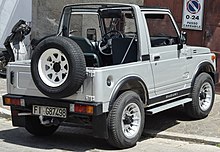
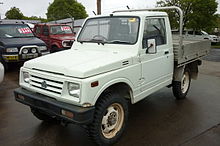
The SJ40 Jimny 1000 was introduced for 1982 to replace the LJ80 range. The Jimny 1000, sold as the Suzuki SJ410 in most export markets, used the F10A - a larger 1-litre version of the LJ's 0.8-litre four-cylinder engine. This engine produced 45 PS (33 kW; 44 hp) and it had a top speed of 68 mph (109 km/h). The Japanese market models claimed 52 PS (38 kW; 51 hp) at 5,000 rpm.[18] So that owners of 550 cc Jimnys would not be able to retrofit the larger, wider wheels of the Jimny 1000 to their cars, the Japanese ministry of transportation dictated that Suzuki fit wheels with a different bolt pattern.[citation needed]
A four-speed manual transmission was standard, as were non-power assisted drum brakes front and rear. The SJ410 came as a half-door convertible, long-wheelbase pickup truck, two-door hardtop (called "Van" in Japan), raised-roof hardtop, and no-glass hardtop (panel van). In Japan, the pickup truck was intended as a bare-bones work vehicle and did not receive fender extensions, and had diagonal tires on black-painted steel wheels rather than the sportier wheels fitted to the regular Jimny. Maximum payload is 350 kg (770 lb).[18] In the autumn of 1983 a covered long-wheelbase version was added for export markets.
The SJ410 was also produced in Spain by Santana Motor in their Linares, Jaén factory as of March 1985 and was sold as a domestic vehicle in Europe due to its over 60% native parts content, thereby evading limits on imports of Japanese-built automobiles.[19] It was built only on the short wheelbase, as a two-door convertible and commercial, or with the three door wagon or van bodywork. Some later models of the SJ410 would switch to disk brakes in the front depending on the factory they were made at. In March 1990, Santana-built versions received the same chassis developments which turned the SJ413 into the Samurai; this version was sold as Samurai 1.0 where it was offered ("Samurai Mil" in Spain).[20] Cooper Motor Corporation (CMC) of Nairobi, Kenya, had been building the first generation Jimny and continued with assembly of the SJ410 in the mid-eighties.[21]
Indonesian production
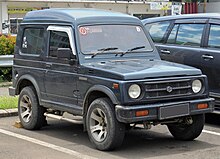
The SJ410 was also assembled in Indonesia by Suzuki Indomobil Motor since late 1982 until 2006, where it was marketed with different names. The original version was marketed as Suzuki Super Jimny, continuing from the previous LJ Suzuki Jimny. The canvas soft-top model was marketed in fairly small numbers from 1983 until late 1985 as Jimny Sierra.[22] In the late 1980s, responding to the introduction of higher taxes for vehicles with four-wheel-drive, Suzuki introduced a 4x2 version as the Suzuki Katana in September 1989.[22] The earlier model built until 1984 were low-roof, metal-bodied wagons. A higher-roofed model arrived in 1984 and continued to be built until about 1988, while the Katana has an even higher roof than the previous versions. Later, there were also 1.3-litre models sold in small numbers as the Jimny Samurai.[22]
As of September 1989, it received updated square headlights. The rear-wheel drive Katana was also used as a basis for an Indonesian-built, 1930s' style kit-car called the Marvia Classic.[23] The earlier Katana is only available with "Blitz" variant until a light facelift in late 1992 (round headlights) and mid-1993 (new grille design with round headlights and "S" logo). In the same year, the Blitz variant was replaced with the long-running GX series Katana. The Suzuki Katana GX was produced from 1993 to 2006, with updates only on body sticker design in 1995, 1997, 1999, 2000, 2002, and 2005. There was also a DX variant of Katana below the GX marketed from 1993 to 2000, after which the GX was the sole variant remaining. Both the GX and DX variants were equipped with power steering as standard. As of March 1995, both the Katana GX and DX received a new redesigned steering wheel with the Suzuki "S" logo. In 2005, Suzuki introduced the SJ413 Caribian Spacecab pickup, which was imported from Thailand and sold until 2007.[22] Production of the second generation Jimny (and Katana) in Indonesia ended in July 2006.
Maruti Gypsy
The Indian built SJ-410 has only ever been available in a long-wheelbase version. The Gypsy remained in production for the Indian Subcontinent market until 2019. The version still produced in India by Maruti Suzuki was the Maruti Gypsy King, using the sixteen valve, 80 PS (59 kW) 1.3-litre G13 engine. The Gypsy King is still popular with the Indian armed forces and police units.
Farm Worker 4x4
In 2013, Suzuki New Zealand reintroduced the Suzuki SJ series into New Zealand badged as the Suzuki Farm Worker 4x4,[24] although the Maruti badge can clearly be seen in the centre of the radiator grille. The vehicle is actually the leaf-sprung Suzuki Maruti Gypsy King MG413W, powered by the G13BB 1.3-litre, 16 valve engine, producing 80 hp (60 kW) at 6,000 rpm and 103 N⋅m (76 lb⋅ft) of torque at 4,500 rpm, mated to a five-speed, all synchromesh gearbox and a high/low 2wd/4wd transfer box. The Farm Worker is available in four slightly differing styles, two having a rear window and fibreglass bulkhead, and two having canvas roofs with foldable front windscreens, all based on the long wheelbase version (the only version built by Maruti) and offering a maximum payload of 500 kg. As its name suggests the Farm Worker is intended for farm work only and is not able to be road registered due to the vehicle not meeting current crash protection regulations,[citation needed] although it does come with seat belts for the front two seats.
SJ413/Samurai
JA51 1300
In 1984, the SJ was revamped with the launch of the SJ413 (internal model code JA51). The SJ413 included a larger 1.3-litre four-cylinder engine, 5-speed manual transmission and power brakes (disc brakes on the front and drum brakes on the rear) all around. The body and interior were also redesigned, with the introduction of a roll bar, along with a new dashboard, seats, and grille. The SJ410 remained in production for various other markets with the old specifications. After the 1988 introduction of the Escudo, sales of the Jimny 1300 ended in Japan. The model returned to the Japanese market in May 1993, after a thorough update.
SJ413 had the same track width as SJ410. As those two car models were relatively susceptible to a rollover, Suzuki introduced a wider edition of SJ413 around 1988, with its track widened by 10 cm. Wider track gave the vehicle more stability. This wider edition received the nameplate "Samurai". The difference in width is the only major difference between SJ413 and Samurai, apart from some minor cosmetic changes in the interior and the exterior.
The Samurai was also produced in a long wheel base (LWB) edition for certain markets, but still with three doors. That LWB edition still had only two rear seats (if fitted at all) for two rear passengers, and the rear passenger leg room was the same as in the standard SWB edition. The extended vehicle length only affected the boot/trunk space behind the rear seats, which was significantly larger in the LWB edition.
North American market
The SJ-Series Samurai was introduced to the United States in 1985 for the 1986 model year. It had gone on sale earlier in Canada and Puerto Rico (as the Suzuki SJ410). It was priced at $6200 when introduced in the United States and 47,000 were sold in its first year. It had a 1.3-litre, 63 hp (47 kW; 64 PS), four-cylinder engine and was available as a convertible or a hardtop, and came equipped with rear seats until 1994. The Suzuki Samurai became intensely popular within the serious 4WD community for its good off-road performance and reliability compared to other 4WDs of the time, outselling the Jeep Wrangler by two to one in 1987.[25] This is due to the fact that while very compact and light, it is a real 4WD vehicle equipped with a transfer case, switchable 4WD and low range. Its lightness makes it a very nimble off-roader less prone to sinking in softer ground than heavier vehicles. It was also sold as the Chevrolet Samurai in Puerto Rico.
The 1988.5 model Samurai was re-tuned for better on-road use in the United States. This revision included softer suspension settings and a larger anti-roll bar to reduce body roll. A lower fifth gear (.865:1 vs the earlier .795:1) increased engine speed and power on the highway, and improved dashboard and seats made the Samurai more comfortable.
A new 1.3 litre four-cylinder engine with throttle-body fuel injection was introduced with 66 hp (49 kW; 67 PS) in September 1991.[20] The Samurai was supplemented in Canada and the United States markets in 1989 by the Suzuki Sidekick, which eventually replaced the Samurai in 1995. The rear seat was removed from 1994 and 1995 Samurai models with rear shoulder safety belts becoming mandatory, and the partial roll cage not having the required mounting provisions, unlike the larger Jeep Wrangler. Low sales and pending stricter safety legislation prompted the withdrawal of the Samurai from Canada and the United States markets after 1995.
Consumers Union lawsuit
An unfavorable 1988 review in Consumer Reports magazine said the Samurai was unsafe and prone to rollovers.[26] In 1996, after investigating the CU's claims, Suzuki of North America sued the magazine's publisher, Consumers Union (CU), for libel. The suit resulted in an inconclusive settlement. CU agreed that it "never intended to imply that the Samurai easily rolls over in routine driving conditions."[27] CU and Suzuki made a joint statement, saying, "CU and Suzuki disagree with respect to the validity" of CU's tests and that "Suzuki disputes the validity" of the tests, while "CU stands by its test protocol and findings."[28]
Ranger kitcar
Rickman Cars developed a GFRP-bodied copy of the Samurai called the Rickman Ranger. Strictly a rear-wheel-drive vehicle, it uses the underpinnings of a Mark II Ford Escort. It was produced in the UK as a kitcar and later in Russia by Avtokam.[29] Rickman, and later the Lomax Company, produced over 1000 vehicles.[30] Avtokam and later Velta produced around 150 further kits.[31] The Velta plant went bankrupt in 2006.[32] Rickman also made a camper version known as the Rancher.
-
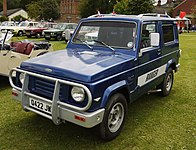 Rickman Ranger/2160 short wheelbase version
Rickman Ranger/2160 short wheelbase version -
 Rickman Space Ranger 2160 long wheelbase version
Rickman Space Ranger 2160 long wheelbase version - The Rickman Rancher.
Other markets

The SJ413/Samurai had a longer history in the rest of the world. Australian market JA51s were sold as either Suzuki Sierra or Holden Drover, while those built in Thailand are called Suzuki Caribian. The Caribian has also been available as the "Caribian Sporty", a unique LWB extended cab pickup.
Due to various trade obstacles for Japanese cars, Spanish Santana Motors (in addition to the SJ410) began local production of the SJ413 in 1986.[19] The Santana built SJs had softer springs for an improved on-road ride, colour coordinated interiors with cloth seats and carpeted floors, all to broaden appeal to those who did not intend to primarily off-road the vehicle.[33] In 1989 it received some optical as well as chassis updates and received the "Samurai" nameplate. Santana-built Samurais did not benefit from the updated coil sprung chassis introduced around 1996, instead receiving a facelift (new grille, more rounded bumpers) specific to European and neighboring markets. Also around 1998, Santana developed a version which used PSA's XUD 9 1.9-litre turbodiesel engine, producing 63 PS (46 kW; 62 hp).[34] Top speed is 130 km/h (80.8 mph).[35] Santana then replaced this diesel Samurai edition with another diesel edition sometime in year 2001, based on Renault's F8Q 1.9-litre non-turbo diesel engine, producing 64 PS (47 kW; 63 hp)). Santana also produced petrol editions alongside the diesel editions. Spanish Samurai production (both for petrol and for diesel editions) ended in late 2003 or early 2004.
The Samurai was sold in Colombia and Venezuela as Chevrolet Samurai, assembled in Bogotá, Colombia by General Motors Colmotores. In other South American markets (Argentina, Bolivia, Brazil, Chile, Peru, Paraguay and Uruguay) it was sold as the Suzuki Samurai. Long wheelbase models were not offered in the Mercosur.

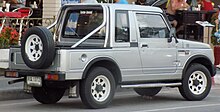
In Asia the SJ/Samurai was sold under a few different names. In Thailand it was called the Suzuki Caribian. The Thai market also received a special version called the "Suzuki Caribian Sporty", a pickup with an extended cab with a small rear seat best suited for occasional use.
High altitude world record

On 21 April 2007, the Chilean duo of Gonzalo Bravo and Eduardo Canales drove their modified Suzuki Samurai (SJ413) up Ojos del Salado to an altitude of 6,688 m (21,942 ft), setting a new record for the highest altitude attained by a four-wheeled vehicle, surpassing the previous record of 6,646 m (21,804 ft) set by a Jeep.
The Samurai in question benefited from wheel, tire, and suspension changes, and a supercharged G16A 4-cylinder engine. It was the third attempt for the two man team, after encountering weather difficulties on the first attempt and an engine fire in the second. The previous record holder's team led by Matthias Jeschke driving a Jeep Wrangler, left a sign reading "Jeep Parking Only: All others don't make it up here anyway". The Chilean team found the sign, blown down by strong winds, and brought it back to civilization as a souvenir.
This record was duly certified by the Guinness World Record in July 2007.[citation needed]
On 13 December 2019, Jeschke reclaimed the record with a Mercedes Benz Unimog.[36]
Kei history

In January 1986 the JA71, a four-stroke, turbocharged and fuel-injected (F5A) 543 cc (33 cu in) three-cylinder engine was introduced to complement the two-stroke SJ30. It used the upgraded interior from the Jimny 1300, which was simultaneously introduced to the SJ30. Power was 42 PS (31 kW; 41 bhp) (JIS gross), although this was increased to 52 PS (38 kW; 51 bhp) (JIS Net) in a November 1987 facelift by adding an intercooler. The non-intercooled engine continued to be offered in the lowest spec Van version. Claimed power was down to 38 PS (28 kW; 37 bhp) as the ratings were switched from gross to net. At the same time, a glassed high-roof version ("Panoramic Roof") was added.[37]
660 cc Era
The JA71 was replaced in March 1990 by the new JA11 as new Kei category regulations took effect. Now with 657 cc on offer, the otherwise similar F6A engine only came with an intercooler and 55 PS (40 kW; 54 bhp). A utilitarian van (HA), as well as more luxurious Hardtop, Convertible, and Panoramic Roof (HC, CC, EC) versions were on offer.[38] The suspension was also upgraded, while a longer front bumper meant that the foglights could be mounted in front of the grille rather than in it. In June 1991, power was increased to 58 PS (43 kW; 57 bhp) and a year later power steering and automatic transmission became available for the first time. Top speed of this version was 120 km/h (75 mph).[20] In February 1995 power increased to 64 PS (47 kW; 63 bhp), but production of the JA11 ended only nine months later with the introduction of the coil spring JA12/22.
Coil spring edition
| Second generation | |
|---|---|
 Suzuki Jimny JA12W series | |
| Overview | |
| Model code | JA12/JA22/JB32 |
| Production | 1995–1998 |
| Assembly | Iwata, Japan |
| Body and chassis | |
| Body style | 2-door wagon 2-door convertible |
| Powertrain | |
| Engine | |
| Transmission | 5-speed manual 3-speed automatic |
| Dimensions | |
| Wheelbase | 2,030 mm (79.9 in) |
| Length | 3,295–3,430 mm (129.7–135.0 in)[39] |
| Width | 1,395–1,550 mm (54.9–61.0 in) |
| Height | 1,670–1,825 mm (65.7–71.9 in) |
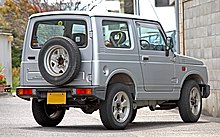
The Samurai continued for sale outside the United States (where the newer version is referred to as the 'Coily'), with a substantial update in November 1995. This included a coil spring suspension, though both live axles were retained. The rest of the truck was redesigned as well, with new seats, dashboard, steering wheel, doors and front grille.
There were three Samurai coil sprung models.
- The JA12 used the 657 cc (40 cu in) F6A three-cylinder engine from the JA11.
- The JA22 received the newly developed and more powerful K6A engine.
- The JB32 received the larger 85 PS (63 kW), 1.3 L (79 cu in) G13BB 16-valve engine. It was slightly longer and wider than the other two models, due to larger bumpers and fenders. This model also bears the designation SJ80. This was the model seen in most export markets, although abroad it was usually equipped with the eight-valve, 70 hp (52 kW) G13BA engine instead.
Additional notes:
- In order to abide by the Kei Jidōsha regulations, claimed output was 64 PS (47 kW) for both engines used in JA12 and JA22, although the K6A produced considerably more power than the F6A.
- As far as it is known, no coil sprung Samurai has ever been produced in a long wheel base edition, but there have been some produced with a raised roof ("high roof") and soft/open top ("cabrio").
- Some vehicle parts are specific to coil sprung Samurais compared to leaf sprung Samurais, and even later Jimny models - most suspension parts, transfer cases, several body panels, as well as most interior and exterior trim pieces.
- JB32 was sold in Europe only during the years 1997 and 1998, and is therefore very rare in Europe, with the availability of the parts specific to JB32 being almost non-existent in local European markets.
Not all production plants switched over to produce coil sprung Samurais. The most notable examples are Maruti Suzuki plant in India (Producing it as the Maruti Gypsy) (still produces the original narrow SJ410 as of year 2020) and Santana plant in Spain (continued producing leaf-sprung Samurais until year 2004). While the third-generation Jimny replaced the Jimny/Samurai in most markets after 1998, it still remains in production in India.
Third generation (1998)
| Third generation | |
|---|---|
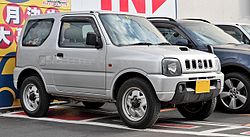  The top Jimny JB23 is compliant with Japan's kei-car class dimensions, by omitting fender flares and having small bumpers. All other versions feature fender flares and larger bumpers, and are known as "Jimny Wide". | |
| Overview | |
| Model code | JB23/JB33/JB43/JB53 |
| Also called | Suzuki Jimny Wide Suzuki Jimny Sierra Chevrolet Jimny Mazda AZ-Offroad Yomper 225 (UK, pickup)[40] KAP Landmaster Dutton Surf |
| Production | 1998–2018 (Japan, Colombia) 1998–2009 (Spain) 1998–2022 (Brazil) |
| Assembly | Iwata, Japan Bogotá, Colombia (GM Colombia) Linares, Spain (Santana Motor) Anápolis,[41] Brazil (MMC Automotores) Catalão, Brazil (MMC Automotores) |
| Body and chassis | |
| Body style | 2-door wagon 2-door convertible |
| Powertrain | |
| Engine | 658 cc K6A I3 (JB23) 1,298 cc G13BB I4 (JB33) 1,328 cc M13A I4 (JB43) 1,461 cc K9K TD I4 (JB53) |
| Transmission | 5-speed manual 4-speed automatic |
| Dimensions | |
| Wheelbase | 2,250 mm (88.6 in) |
| Length | Kei class: 3,395 mm (133.7 in) Others: 3,675 mm (144.7 in)[42] |
| Width | Kei class: 1,475 mm (58.1 in) Others: 1,600 mm (63.0 in)[42] |
| Height | 1,680–1,705 mm (66.1–67.1 in)[42] |
| Chronology | |
| Successor | Mazda Flair Crossover (indirect) |



At the 1997 Tokyo Motor Show, Suzuki presented the all-new Jimny with a much more modern design.[43] A ladder type chassis and a dual-ratio transfer case were retained, unlike many competing compact 4WDs which lack a low range, and are strictly in the crossover category. Two versions are available in export markets: a standard hard top and the Canvas Top, introduced at the Barcelona Motor Show in May 1999 and was built only by Santana in Spain between 1999 and 2009.[19] The Jimny replaced the popular Sierra/Samurai model in most markets (European introduction was in Paris, 1998[44]), though its predecessor remains in limited production in some places. For the domestic market, a 660 cc K6A-engined version suited for the Kei Jidosha class is responsible for most Jimny sales.
The larger 1.3-litre Jimny was originally equipped with the G13BB engine also used in the JB32. The 80 PS (59 kW) G13BB engine was replaced in Japan with the January 2000 introduction of the newly designed VVT 16-valve M-engine, but soldiered on in Spanish-built softtops until 2005.[45] For the continental European market, where the diesel cars hold a significant market share, in 2004 the turbo-diesel Jimny JB53 was introduced, built by Santana and using a Renault-built DDiS 1,461 cc K9K engine. Power was originally 65 PS (48 kW) but was increased to 86 PS (63 kW) in 2005, the same as in gasoline versions.[43] It was discontinued in 2011, and was never available in Britain and Ireland.
The Jimny has a part-time 4WD system controlled by three dashboard buttons: 2WD, 4WD, and 4WD-L. The default is 2WD, powering the rear wheels. When 4WD is pressed, the front wheels are also engaged in high gear. The 4WD-L engages all wheels in a lower gear ratio. Being a part-time 4WD, there is no centre differential or viscous coupling to allow for speed differences between the front and rear wheels, so only two-wheel drive mode works well on dry pavement. In Japan, the "Sierra" name was revived in January 2002, when 1.3-litre Jimnys began to be sold as the "Jimny Sierra" rather than as the "Jimny Wide".
The Jimny's vacuum-locking hubs allow it to be shifted from 2WD to 4WD while travelling at up to 100 km/h (62 mph). Shifting to low range requires the vehicle to be stopped, but no need to exit the vehicle exists. Newer Jimnys have electronic push-button selectable four-wheel drive, which requires the vehicle to be stopped with the clutch depressed and transmission in neutral to select low range.
The Jimny has large windows, giving excellent visibility, apart from a rather serious blind spot caused by the oversized "B" pillar.[opinion] The large amount of glass also magnifies the greenhouse effect, and the Jimny comes with air conditioning standard in some regions.
In Europe, both Hard Top and Canvas Top versions come in JX and JLX specifications. These are fairly standard designations across the Suzuki off-road range, with the JLX being the fully optioned "luxury" version. In the case of the Jimny, the JLX adds roof rails, power steering, power windows, power-adjustable exterior mirrors, and several interior comfort improvements. Both models are available with a five-speed manual or four-speed automatic gearbox. The 2WD option is only available as a five-speed manual.
In 2009, Santana Motor of Spain ended its agreement with Suzuki to make the Canvas Top version, which has not been available since then. In 2011, Santana Motor went bankrupt. The Souza Ramos Group of Brazil, which used to make Mitsubishi cars under license, will start manufacturing the Suzuki Jimny in 2012 in Brazil to compensate for the loss of production capacity from Santana Motor. Whether the Canvas Top version will be manufactured also in Brazil is not known.
As in Japan, Jimnys in Australia have borne the name Jimny Sierra since 2007, largely due to the Sierra name having become synonymous with small, capable off-road vehicles. Since 1999, GM Colmotores have been assembling the 1.3-litre, 79 PS (58 kW) JB33 with the name "Chevrolet Jimny" in Bogotá, Colombia.[46] The Jimny is also available as a parallel import in Singapore.
In 2012, for the 2013 model year, the Jimny received a front facelift, giving it a more angular grille and front bumper, and including a hood scoop. For the Indonesian market, the facelifted Jimny was launched at the 25th Gaikindo Indonesia International Auto Show on 10 August 2017, and 88 units were sold exclusively for a limited time only.
Production of third generation Jimny ceased worldwide (except in Brazil) in 2018 after 20 years of production, as Suzuki retooled in preparation of the fourth generation's launch in late 2018.
In 2021, a British company called Yomper 4×4 started to produce a couple of pickups based on the third generation Jimny, with their Bergan model having a shorter wheelbase than the version known as the Yomper 4×4 Commercial.[47] In 2022, Suzuki Brazil[48] stopped production[41] of the third generation Jimny at their Catalao plant, due to new regulations which meant they could not use the car's 1.3-litre M13A engine without updating it. At that time Suzuki Brazil's range[49] consisted of two Jimny models, with the fourth generation model known as the "Jimny Sierra" and the facelifted third generation on sale in four different versions (all with M13A engine) [50][51] with the Jimny 4Work being the base model and the Jimny Forest being the top-of-the-range model.
-
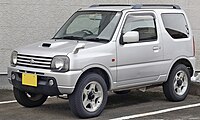 Jimny (JB23; first facelift)
Jimny (JB23; first facelift) - Jimny (JB23; second facelift)
-
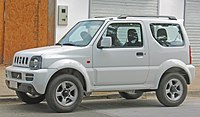 Jimny Sierra (JB43; 2005 facelift)
Jimny Sierra (JB43; 2005 facelift) -
 Jimny Sierra (JB43; 2012 facelift)
Jimny Sierra (JB43; 2012 facelift) - Jimny Sierra (JB43; 2012 facelift) with front mesh grille and two-tone exterior colour
Mazda AZ-Offroad

The Mazda AZ-Offroad, introduced in October 1998, is a rebadged Jimny. The AZ in the name refers to Autozam, Mazda's ill-fated small car marque. It is fitted with the turbocharged 658-cc DOHC Suzuki K6A engine, which produces 64 PS (47 kW).[52] Manually operated four-wheel drive is standard with autolocking front hubs and low range, whilst an automatic transmission is optional.
Fourth generation (2018)
| Fourth generation | |
|---|---|
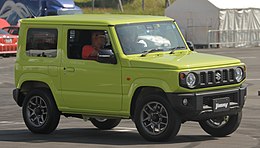  The Jimny JB64 pictured top is compliant with Japan's kei-car class dimensions, omitting fender flares and having tucked-in bumpers. All other (export) versions have pronounced fender flares and larger bumpers. | |
| Overview | |
| Model code | JB64W/JB74W |
| Also called | Suzuki Jimny Sierra |
| Production | 2018–present |
| Assembly |
|
| Designer | Hiroyuki Yonezawa |
| Body and chassis | |
| Body style | 3-door wagon 5-door wagon[55][56] |
| Powertrain | |
| Engine | |
| Transmission | |
| Dimensions | |
| Wheelbase |
|
| Length |
|
| Width |
|
| Height |
|
| Curb weight |
|
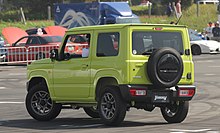

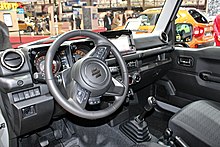


The fourth generation Jimny[57] and Jimny Sierra were launched in Japan on 5 July 2018,[58] with styling reminiscent of the earlier LJ and SJ generations.[59][60] Production commenced in Japan on 29 May 2018 at Suzuki's Kosai plant.[53]
In January 2023, Suzuki released the long-wheelbase 5-door version of the Jimny, based on the Sierra version, using the emission compliant 1.5L K15B engine.[56][61]
Design
The body-on-chassis design uses a ladder frame, 3-link rigid axle suspension with coil spring, and part-time four-wheel drive with low range transfer gear, marketed as ALLGRIP PRO. Transmission options are a 5-speed manual transmission and a 4-speed automatic.
The exterior has upright A-pillars, a flat clamshell bonnet/hood, driver and passenger window lines that dip at the front to extend visibility, a simple black grille with round headlamps, roof edge drip rails, and prominent wheel arch extensions. The interior rear luggage space can be expanded by folding twin rear seats, creating a 377-litre luggage space with a flat floor, five utility screw holes and four luggage anchors. The design results in an approach angle of 37 degrees, ramp breakover angle of 28 degrees and departure angle of 49 degrees.[53]
The Jimny incorporates a series of safety features, marketed by Suzuki as Suzuki Safety Support.[53] The Dual Sensor Brake Support (DSBS) system determines if there is a risk of forward collision and issues an audio and visual warning, increases braking force, or applies automatic braking to either avoid a collision or minimize damage. Other functions include lane departure warning, weaving alert function and high beam assist, which automatically switches between high and low beams.[62]
Engines
The base Japanese market Jimny is powered by an R06A 658 cc, three-cylinder, turbocharged petrol engine, while the wide version (Jimny Sierra) has a newly developed K15B 1.5-litre four-cylinder naturally aspirated petrol engine (75 kW (102 PS; 101 hp) at 6,000 rpm, 138 N⋅m (14.1 kg⋅m; 102 lb⋅ft) at 4,400 rpm).[63]
Markets
Japan
For its home market, the kei car version sold simply as the Jimny and the standard wheelbase version sold as the Jimny Sierra. The Jimny comes in XG, XL and XC grades, whereas, the Jimny Sierra comes in JL and JC grades. All variants have the option between a 5-speed manual or a 4-speed automatic.[64]
Europe
The Jimny made its European debut starting in Germany in October 2018.[65][66]
In 2020, the Jimny was discontinued from European markets due to its high CO² emissions and stringent EU emission regulations. It was introduced in 2021 as a commercial vehicle that is subjected to less stringent EU emissions regulations, with the rear seats removed and a partition separates the boot space from the front seats.[67]
South Africa
The Jimny was launched in South Africa on 2 November 2018, with two grades: GA and GLX, it is available with either a 5-speed manual or a 4-speed automatic.[68]
In March 2022, a new mid-range GL grade was added.[69]
In November 2023, the Jimny 5-door debuted in South Africa with two grades: GL and GLX.[70]
Australia
The Jimny was launched in Australia on 24 January 2019, in a sole GLX grade, it is available with either a 5-speed manual or a 4-speed automatic.[71]
In June 2021, the entry level Lite grade was added. The Lite grade has steel wheels, headlights uses halogen units instead of LED, and the touchscreen head unit has been replaced with a basic audio head DIN unit.[72]
In December 2023, the Jimny 5-door debuted in Australia as the Jimny XL.[73]
New Zealand
The Jimny was launched in New Zealand on 14 March 2019 as the Jimny Sierra, in a sole variant, it is available with either a 5-speed manual or a 4-speed automatic.[74]
In January 2024, the Jimny 5-door debuted in New Zealand.[75]
Philippines
The Jimny was launched in the Philippines on 8 March 2019, with two grades: GL (with manual) and GLX (with automatic).[76]
In January 2024, the Jimny 5-door debuted in the Philippines, with two grades: GL (with manual) and GLX (with automatic).[77]
Singapore
The Jimny was launched in Singapore on 27 April 2019, as a sole variant paired only to a 4-speed automatic.[78]
Thailand
The Jimny was launched in Thailand on 27 March 2019 at the 40th Bangkok International Motor Show, in a sole unnamed grade, it is available with either a 5-speed manual or a 4-speed automatic.[79]
Indonesia
The Jimny was launched in Indonesia on 18 July 2019 at the 27th Gaikindo Indonesia International Auto Show, after being previewed at the 26th Gaikindo Indonesia International Auto Show. For Indonesia, the Jimny comes in a sole unnamed grade, it is available with either a 5-speed manual or a 4-speed automatic.[80]
In February 2024, the Jimny 5-door debuted in Indonesia at the 31st Indonesia International Motor Show.[81]
Mexico
The Jimny was launched in Mexico on 12 November 2020, in a sole GLX grade, it is available with either a 5-speed manual or a 4-speed automatic.[82] The 2021 model year Jimny was sold out in 3 days after the first 1,000 reserved units.[83]
India
Assembly of the Jimny started in India since January 2021 as an export model. The 3-door Indian-made Jimny has been exported to African markets and countries in the Middle East.[84]
In January 2023, the 5-door Jimny was introduced for the domestic market.[85] The model was launched in India on 7 June 2023 with two grades: Zeta and Alpha, and is exclusively available at the Nexa dealership chain reserved for high-end Maruti Suzuki models.[86] In October 2023, the 5-door Jimny began exporting to the Middle East, Latin America, South Africa, and Southeast Asia.[87]
GCC
The 3-door Jimny was launched in the GCC markets in February 2021, it is available in two grades, GL (with manual) and GLX (with automatic).[88]
On 1 November 2023 the 5-door Jimny was launched in the GCC markets.[citation needed]
Malaysia
The Jimny was launched in Malaysia on 30 September 2021, in a sole variant, paired only to a 4-speed automatic.[89]
Safety
| Test | Points | % |
|---|---|---|
| Overall: |      | |
| Adult occupant: | 27.9 | 73% |
| Child occupant: | 41.4 | 84% |
| Pedestrian: | 25.1 | 52% |
| Safety assist: | 6.5 | 50% |
-
 Suzuki Jimny Sierra Pick Up Style Concept (JB74)
Suzuki Jimny Sierra Pick Up Style Concept (JB74) -
 Suzuki Jimny Sierra Pick Up Style Concept (JB74)
Suzuki Jimny Sierra Pick Up Style Concept (JB74) -
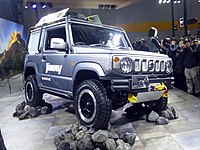 Suzuki Jimny Survive Concept (JB64)
Suzuki Jimny Survive Concept (JB64) -
 Suzuki Jimny Survive Concept (JB64)
Suzuki Jimny Survive Concept (JB64)
Electric version
An electric version of the Jimny is confirmed and scheduled to release around 2030.[91]
Development history
These four collapsed tables cover the development history of the Jimny in the Japanese domestic market, with notable export variations and developments also noted.
| Jimny development in the 1st generation (1970-1981) | |||||||||||||||||||||||||||||||||||||||||||||||
|---|---|---|---|---|---|---|---|---|---|---|---|---|---|---|---|---|---|---|---|---|---|---|---|---|---|---|---|---|---|---|---|---|---|---|---|---|---|---|---|---|---|---|---|---|---|---|---|
| |||||||||||||||||||||||||||||||||||||||||||||||
| Jimny development in the 2nd generation (1981-1998) | |||||||||||||||||||||||||||||||||||||||||||||||||||||||||||||||||||||||||||||||||||||||||||||||||||||||||||
|---|---|---|---|---|---|---|---|---|---|---|---|---|---|---|---|---|---|---|---|---|---|---|---|---|---|---|---|---|---|---|---|---|---|---|---|---|---|---|---|---|---|---|---|---|---|---|---|---|---|---|---|---|---|---|---|---|---|---|---|---|---|---|---|---|---|---|---|---|---|---|---|---|---|---|---|---|---|---|---|---|---|---|---|---|---|---|---|---|---|---|---|---|---|---|---|---|---|---|---|---|---|---|---|---|---|---|---|
| |||||||||||||||||||||||||||||||||||||||||||||||||||||||||||||||||||||||||||||||||||||||||||||||||||||||||||
| Jimny development in the 3rd generation (1998-2018) | ||||||||||||||||||||||||||||||||||||||||||||||||||||||||||||||||||||||||||||||||||||||||||
|---|---|---|---|---|---|---|---|---|---|---|---|---|---|---|---|---|---|---|---|---|---|---|---|---|---|---|---|---|---|---|---|---|---|---|---|---|---|---|---|---|---|---|---|---|---|---|---|---|---|---|---|---|---|---|---|---|---|---|---|---|---|---|---|---|---|---|---|---|---|---|---|---|---|---|---|---|---|---|---|---|---|---|---|---|---|---|---|---|---|---|
| ||||||||||||||||||||||||||||||||||||||||||||||||||||||||||||||||||||||||||||||||||||||||||
| Jimny development in the 4th generation (2018–present) | ||||||||||||||
|---|---|---|---|---|---|---|---|---|---|---|---|---|---|---|
| ||||||||||||||
Sales
| Year | Japan[98] | Europe[99] |
|---|---|---|
| 1998 | 4,171 | |
| 1999 | 19,431 | |
| 2000 | 21,351 | |
| 2001 | 16,780 | 19,865 |
| 2002 | 14,885 | 21,541 |
| 2003 | 13,803 | 21,182 |
| 2004 | 13,732 | 26,674 |
| 2005 | 14,715 | 27,007 |
| 2006 | 16,472 | 28,388 |
| 2007 | 15,465 | 27,783 |
| 2008 | 14,948 | 21,880 |
| 2009 | 11,222 | 20,681 |
| 2010 | 11,444 | 17,473 |
| 2011 | 12,958 | 12,923 |
| 2012 | 14,733 | 12,467 |
| 2013 | 15,590 | 10,713 |
| 2014 | 14,593 | 10,787 |
| 2015 | 12,973 | 12,271 |
| 2016 | 13,267 | 13,184 |
| 2017 | 12,487 | 14,710 |
| 2018 | 20,942 | 10,438 |
| 2019 | 30,281 | 16,605 |
| 2020 | 38,056 | 10,063 |
| 2021 | 39,422 | 563 |
| 2022 | 41,405 | 459 |
| 2023 | 39,910 |
References
- ^ a b "Suzuki Jimmy toughens up with pick-up and explorer concepts". CAR Magazine.
- ^ a b c d e f "【名車探訪】 SUZUKI ジムニー(初代)" [Visiting a famous car: Suzuki Jimny (first generation)]. Goo-net (in Japanese). Proto Corporation. 26 July 2018.
- ^ "History of Suzuki 4x4: 1975". Suzuki Motor Corporation. Archived from the original on 28 March 2019. Retrieved 28 July 2010.
- ^ "HopeStar ON360, 1968 [Auta5P ID:6724 EN]".
- ^ 360cc Light Commercial Truck 1950-1975 (360cc 軽商用貨物自動車 1950-1975). Tokyo: Yaesu Publishing. 2009. p. 34. ISBN 978-4-86144-139-4.
- ^ Ozeki, Kazuo (2007). Suzuki Story: Small Cars, Big Ambitions (in Japanese). Tokyo: Miki Press. p. 84. ISBN 978-4-89522-503-8.
- ^ a b 1979 Suzuki Stockman 4WD Ad - Australia, www.flickriver.com Retrieved 11 July 2016
- ^ Brock, Bill (22 May 1982). "From Mombasa to Nairobi with Leyland's Land Train". Commercial Motor. Vol. 155, no. 3966. p. 56.
- ^ a b Car Graphic: Car Archives Vol. 5, '70s Japanese Cars (in Japanese). Tokyo: Nigensha. 2007. p. 145. ISBN 978-4-544-09175-5.
- ^ Quattroruote: Tutte le Auto del Mondo 74/75. Milano: Editoriale Domus S.p.A. 1974. p. 846.
- ^ World Cars 1976. Bronxville, NY: L'Editrice dell'Automobile LEA/Herald Books. 1976. pp. 378–379. ISBN 0-910714-08-8.
- ^ "Suzuki 4WD 'far from toy'". The Canberra Times. 52 (15, 612). Canberra: 20. 20 June 1978. Retrieved 7 February 2021.
- ^ www.suzuki-samurai.nl Retrieved 11 July 2016
- ^ 1985 Holden Drover 4wd original 12 page Australian brochure, www.ebay.com.au via web.archive.org Retrieved 11 July 2016
- ^ a b "Macam-macam Suzuki Jimny dan Katana di Indonesia". 13 January 2017.
- ^ "Maruti Suzuki Jimny Exports To Begin In 2021, Before India Launch". v3cars.com. Retrieved 12 February 2020.
- ^ "日本最後の2ストエンジン搭載!実は歴代最強?スズキ ジムニー SJ30" [Japan's last 2-stroke engine! Actually the strongest in history? Suzuki Jimny SJ30]. MOTA Corporation. 4 June 2020.
- ^ a b Jimny 1000 (Catalog), Suzuki Motor Co, 1982, 99999-30000-700
- ^ a b c World of Cars 2006·2007. Warsaw, Poland: Media Connection Sp. z o.o. 2006. pp. 76–77.
- ^ a b c Quattroruote: Tutte le Auto del Mondo 1992. Milano: Editoriale Domus S.p.A. 1992. pp. 1323–1327.
- ^ Mastrostefano, Raffaele, ed. (1985). Quattroruote: Tutte le Auto del Mondo 1985 (in Italian). Milano: Editoriale Domus S.p.A. p. 225. ISBN 88-7212-012-8.
- ^ a b c d Alfan, Charis (13 January 2017). "Macam-macam Suzuki Jimny dan Katana di Indonesia" [The various kinds of Suzuki Katanas and Jimnys in Indonesia]. Mobil Motor Lama. Archived from the original on 13 June 2017.
- ^ Tutte le Auto del Mondo 1992, p. 460
- ^ "Suzuki New Zealand - Farm Worker". Archived from the original on 20 April 2015. Retrieved 14 January 2015. Suzuki NZ Farm Worker website
- ^ "Here's Why The Tiny Suzuki Samurai Outsold The Jeep Wrangler 2 to 1 in 1987!" – via www.youtube.com.
- ^ Levine, Doron P. (3 June 1988). "Consumer Group Asks Recall Of Suzuki Samurai as Unsafe". New York Times.
- ^ "Suzuki lawsuit dismissed", consumerreports.org, archived from the original on 12 March 2007, retrieved 13 August 2006
- ^ "Suzuki and Consumers Union agree on dismissal of lawsuit". Consumerreports.org. 13 April 2010. Retrieved 13 November 2011.
- ^ https://forum.azlk-team.ru/index.php/topic,39636.0.html Russian
- ^ "RCOC History Page". Archived from the original on 11 August 2013.
- ^ "Как на патефонном заводе подвеску к "Москвичу" и пластиковый джип делали". ПермАвтоПром. Archived from the original on 16 December 2017. Retrieved 16 December 2017.
- ^ "Открытое акционерное общество "Велта"". Archive.perm.ru. Archived from the original on 29 October 2017. Retrieved 23 July 2017.
- ^ Off Road and 4 Wheel Drive July 1987. Poole, England: Link House Publications. 1987.
- ^ de Miguel, Carlos (26 January 1998). "Suzuki en España: fabricante de automóviles japonés consolida su presencia en España con nuevos modelos" [Suzuki in Spain: Japanese car manufacturer consolidates its presence in Spain with new models]. Epoca (in Spanish) (674). Difusora de Informacion Periodica, S.A. [DINPESA]: 96.
- ^ Katalog der Automobil Revue 2002. Berne, Switzerland: Revue Automobile. 2002. pp. 552–553.
- ^ "Unimog expedition team wins the world altitude record. - MBS World".
- ^ Car Graphic: Car Archives Vol. 11, '80s Japanese Cars. Tokyo: Nigensha. 2007. pp. xx. ISBN 978-4-544-91018-6.
- ^ a b "U's Station On the Net - Short Catalog by Model". Suzuki Motor Corporation. Archived from the original on 9 December 2008. Retrieved 27 June 2010.
{{cite web}}: CS1 maint: bot: original URL status unknown (link) - ^ Auto Katalog 1997. Stuttgart: Motor Presse International. 1996. pp. 232–235.
- ^ "New Yomper 4x4 Launched In The UK As A Cute Pickup Based On The Previous-Gen Suzuki Jimny". Carscoops. 18 November 2021. Retrieved 18 November 2021.
- ^ a b "Previous-Gen Suzuki Jimny Finally Discontinued In Brazil". Carscoops. Retrieved 12 August 2022.
- ^ a b c "Jimny:Specifications | Global Suzuki". Archived from the original on 29 September 2013.
- ^ a b World of Cars 2006·2007. Warsaw, Poland: Media Connection Sp. z o.o. 2006. pp. 188–190, 398–399.
- ^ World of Cars 2006·2007. Warsaw, Poland: Media Connection Sp. z o.o. 2006. p. 188.
- ^ Auto Katalog 2005. Stuttgart: Motor Presse International. 2004. pp. 171, 256–257.
- ^ World of Cars 2006·2007. Warsaw, Poland: Media Connection Sp. z o.o. 2006. p. 28.
- ^ "New Yomper 4x4 Launched In The UK As A Cute Pickup Based On The Previous-Gen Suzuki Jimny". Carscoops. 18 November 2021. Retrieved 12 August 2022.
- ^ "Suzuki Jimny's Previous Generation Has Been Phased Out In Brazil". Allautoexperts.com. Retrieved 12 August 2022.
- ^ "Suzuki Veц╜culos Brasil". Suzukiveiculos.com.br. Retrieved 12 August 2022.
- ^ https://www.suzukiveiculos.com.br/veiculos/jimny-forest Archived 1 December 2021 at the Wayback Machine Jimny
- ^ "Suzuki Jimny 4SPORT 2022 - Carros Novos | Suzuki Veц╜culos". Suzukiveiculos.com.br. 31 July 2022. Retrieved 12 August 2022.
- ^ "Автомобиль Mazda Az-offroad". Avto-Russia.ru. Retrieved 25 June 2013.
- ^ a b c d "Suzuki Launches the All-New Jimny 4WD Vehicles in Japan". Suzuki. 5 July 2018. Retrieved 26 September 2018.
- ^ "Maruti Suzuki starts production of Jimny SUV in India". www.timesnownews.com. 20 January 2021. Retrieved 20 January 2021.
- ^ "Suzuki Jimny 5-Door Debuts Adding Extra Practicality Into The Mix". Carscoops. 12 January 2023.
- ^ a b "2023 Suzuki Jimny 5-Door Debuts To Show Bigger Is Better". Motor1.com.
- ^ "Suzuki официально представила новый Jimny". www.pushcar.ru/ (in Russian). Retrieved 9 September 2022.
- ^ Sheehan, Sam (5 July 2018). "2019 Suzuki Jimny engine and gearbox options revealed". Autocar. Retrieved 26 September 2018.
- ^ James Dennison (21 September 2018). NEW 2018 Suzuki Jimny review | A replacement for the Land Rover Defender? (online video review). Car. Event occurs at 1:00. Archived from the original on 13 November 2021. Retrieved 25 September 2018.
- ^ Mat Watson (19 September 2018). New Suzuki Jimny SUV 2019 - see why I love it... but you might not! (online video review). Carwow. Event occurs at 1:00. Archived from the original on 13 November 2021. Retrieved 25 September 2018.
- ^ "All-New Jimny 5-Door and All-New SUV Fronx Unveiled in India". globalsuzuki.com. Retrieved 12 January 2023.
- ^ "2019 Suzuki Jimny: Official images released". ZigWheels. 22 June 2018. Retrieved 26 September 2018.
- ^ Rivan RS (26 June 2018). "Suzuki Jimny to share K15B petrol engine with new Ciaz". Autocar India. Retrieved 26 September 2018.
- ^ "スズキ、軽四輪駆動車 新型「ジムニー」、小型四輪駆動車 新型「ジムニーシエラ」を発売|スズキ" [Suzuki releases new light 4-wheel drive vehicle "Jimny" and new compact 4-wheel drive vehicle "Jimny Sierra" | Suzuki]. スズキ、軽四輪駆動車 新型「ジムニー」、小型四輪駆動車 新型「ジムニーシエラ」を発売|スズキ (in Japanese). 5 July 2018. Retrieved 25 February 2024.
- ^ Mihalascu, Dan (20 September 2018). "Well-Equipped 2019 Suzuki Jimny Starts From €17,915 In Germany". Carscoops.
- ^ Sheehan, Sam (2 October 2018). "2019 Suzuki Jimny UK pricing revealed". Autocar. Retrieved 25 February 2024.
- ^ Pappas, Thanos (1 July 2021). "Suzuki Jimny Returns To UK As Two-Seater LCV From £16,796". Carscoops.
- ^ Oldfield, Ashley (2 November 2018). "Suzuki Jimny (2018) Specs & Price". Cars.co.za. Retrieved 25 February 2024.
- ^ Du Toit, Albert (2 March 2022). "New mid-range Suzuki Jimny – South African pricing and specifications". TopAuto. Retrieved 25 February 2024.
- ^ Taylor, Michael (14 November 2023). "New Suzuki Jimny 5-door officially launched in South Africa – Pricing and features". TopAuto. Retrieved 25 February 2024.
- ^ O'Kane, Tony (24 January 2019). "2019 Suzuki Jimny price and features". WhichCar. Retrieved 25 February 2024.
- ^ Costello, Mike (29 June 2021). "2021 Suzuki Jimny Lite pricing revealed". CarExpert. Retrieved 25 February 2024.
- ^ Stopford, William (5 December 2023). "2024 Suzuki Jimny XL price and specs". CarExpert. Retrieved 25 February 2024.
- ^ Galvin (JSG), John (13 March 2019). "2019 Suzuki Jimny New Zealand Launch". DriveLife. Retrieved 25 February 2024.
- ^ Alvrez, Fred (22 January 2024). "2024 Suzuki Jimny 5-door - LAUNCH". DriveLife. Retrieved 25 February 2024.
- ^ "2019 Suzuki Jimny makes Philippine debut, starts at P975K". AutoDeal. 8 March 2019. Retrieved 25 February 2024.
- ^ Grecia, Leandre (25 January 2019). "Suzuki Jimny 5-Door officially launched in PH with a P1.558-M starting price". TopGear Philippines.
- ^ Wong, Derryn (27 April 2019). "The Suzuki Jimny returns to Singapore, priced below S$120k with COE - CarBuyer Singapore". Online Car Marketplace for Used & New Cars. Retrieved 25 February 2024.
- ^ "ราคาอย่างเป็นทางการ Suzuki Jimny SIERRA 1.5 MT / AT 4WD : 1,550,000 - 1,650,000 บาท (นำเข้า CBU)". HeadLight Magazine (in Thai). 26 March 2019. Retrieved 25 February 2024.
- ^ Andebar, Wisnu (18 July 2019). "Akhirnya Suzuki Jimny Resmi Meluncur di GIIAS 2019, Segini Harganya". GridOto.com (in Indonesian). Retrieved 25 February 2024.
- ^ Maulia, Yussy (21 February 2024). "Suzuki Jimny 5-Door Resmi Meluncur di IIMS 2024, Menambah Line-up Mobil Legendaris!". GridOto.com (in Indonesian). Retrieved 25 February 2024.
- ^ Hoyo, Rubén (13 November 2020). "Suzuki Jimny 2021 llega a México, el 4x4 más esperado". Autocosmos (in Mexican Spanish). Retrieved 25 February 2024.
- ^ Zapata, Astrid (18 November 2020). "El Suzuki Jimny 2021 se agota en solo 3 días". Autocosmos (in Mexican Spanish). Retrieved 25 February 2024.
- ^ "Maruti Suzuki starts exporting the Jimny SUV from India". Autocar India. Retrieved 20 January 2021.
- ^ "Auto Expo 2023: Maruti Suzuki Jimny 5-door makes global debut". Autocar India. Retrieved 12 January 2023.
- ^ "Maruti Jimny Price Starts From Rs 12.74 Lakh | CarDekho.com". CarDekho. 7 June 2023. Retrieved 25 February 2024.
- ^ "Made-In-India Maruti Suzuki Jimny 5-Door Now Exported Overseas". ZigWheels. Retrieved 11 November 2023.
- ^ "New Suzuki Jimny 2022". Yallamotor. Retrieved 11 November 2023.
- ^ Lee, Jonathan (30 September 2021). "2021 Suzuki Jimny in Malaysia – mini 4x4 priced at RM169k - paultan.org". Paul Tan's Automotive News. Retrieved 25 February 2024.
- ^ "Suzuki Jimny (2018)". Euro NCAP. Retrieved 24 September 2018.
- ^ "Battery-electric Suzuki Jimny confirmed for Europe". Autocar. Retrieved 31 January 2023.
- ^ "U's Station On the Net - Short Catalog by Model". Suzuki Motor Corporation. Archived from the original on 31 August 2008. Retrieved 27 June 2010.
{{cite web}}: CS1 maint: bot: original URL status unknown (link) - ^ Ozeki 2007, pp. 87–88.
- ^ Tutte le Auto del Mondo 1985, p. 1284
- ^ a b c Ozeki 2007, pp. 91–92.
- ^ "U's Station On the Net - Short Catalog by Model". Suzuki Motor Corporation. Archived from the original on 17 July 2006. Retrieved 27 June 2010.
{{cite web}}: CS1 maint: bot: original URL status unknown (link) - ^ a b "Electronic Stability Control and Traction Control systems - BigJimny Wiki".
- ^ "スズキ ジムニー 新車販売台数/売れ行き(生産台数)と生産状況は?生産工場も - 株式会社アイディーインフォメーション" [What is the Suzuki Jimny new car sales volume/sales (production volume) and production status? Production factory too - ID Information Co., Ltd.]. id-information.co.jp. Retrieved 25 February 2024.
- ^ "Suzuki Jimny Sales Figures". GCBC. Retrieved 25 February 2024.
Further reading
- "Suzuki's 4x4 History". Suzuki global site.
- "Suzuki's 4x4 History". Suzuki Japan.
- "Suzuki's 4x4 History". Off-Road.com. Archived from the original on 17 February 2006. Retrieved 2 March 2006.
- "BigJimny wiki documentation". Dedicated fan-made wiki about 3rd gen. Jimnys - buying, owning, using, modding, repairing.
External links

- Official website
- Official website (New Zealand)
- official website (Australia)
- Jimny subreddit
- 2019 Jimny offroad review – Autocar magazine video
- v
- t
- e
joint ventures
- Changan Suzuki (defunct)
- Jatco (10%)
- Magyar Suzuki
- Maruti Suzuki (56.21%)
- Pak Suzuki Motors (73.09%)
- Suzuki Indomobil Motor (94.94%)
- Suzuki Motor Gujarat
| Kei cars |
|
|---|---|
| Cars |
|
| Pickup trucks | |
| Crossovers/SUVs |
|
| MPVs/Minivans |







